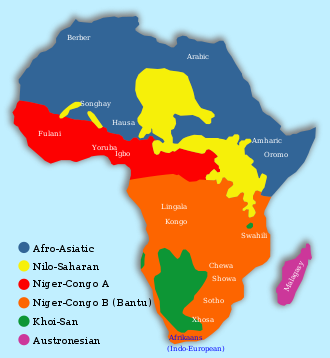Official estimates state that there are 2,000 languages spoken throughout the continent of Africa, which are then broken down into these groups:
* Afro-asiatic: these languages are spoken in many countries of northern, eastern and southwestern Africa. The family of Afro-asiatic languages includes approximately 240. The main ones are the Semitic family, Kushite, Berber, and Chadic.
* Nilo-saharan: this group of languages is spoken mainly in Sudan, Ethiopia, Uganda, Kenya and northern Tanzania. The family consists of more than 100 languages. The best known are Turkana (Kenya), Maasai (Kenya and Tanzania), Kanuri (Nigeria) and Songhay (Mali).
* Niger-Congo: this set of languages covers western, central and southeastern Africa. This is the family that has the most languages within it. The Bantu family includes many languages of this family.
* Khoisan: this family accounts for about 50 languages, which are found mainly in Namibia, Botswana and Angola.
* Non-African: there are languages that belong to non-African families, with origins outside of the continent, for example, Malagasy, the main language of Madagascar, and Gujarat, which comes from India.
* Indo-European: this group is concentrated in the south of the continent. Its presence is closely related to Africa’s colonial history. Some have a strong imprint of European languages, like English in Sierra Leone, Portuguese Creole of Guinea-Bissau and Cape Verde, Creole French in the Seychelles, or Mauritian Creole in Mauritius. Also others of Arab origin, such as Juba Arabic in southern Sudan, or Nubi in parts of Uganda and Kenya.
African countries boast an impressive cultural diversity, which in turn is reflected in the many languages that coexist there. While not all have the distinction of “official”, all are heard and spoken and respected. For example, all African languages are considered official languages of the African Union (AU). And many times, though they are not recognized as a country’s official languages are heard on the radio, read in newspapers and taught in schools.
And as necessary aspects of every language, practice and tradition are what keep them alive.
Here’s our small contribution to keep them present, for those who need to know more about them now, or for those who may need to know about them at some time in the future.
You can direct your inquiry to “Translation Services.”
(Spanish version: https://www.trustedtranslations.com/las-lenguas-de-africa-2011-01-19.html)
Se estima que en todo el continente africano se hablan unas 2.000 lenguas, que se pueden encontrar en estos grupos, según la zona geográfica que los contenga:
* Afroasiáticas: se hablan en muchos países de África del norte, del este y del suroeste. La familia de lenguas afro-asiáticas comprende aproximadamente 240. Las principales son las familias semítica, cushítica, bereber, y chádica.
* Nilo-sahararianas: son un grupo de lenguas principalmente habladas en Sudán, Etiopía, Uganda, Kenia, y el norte de Tanzania. La familia consta de más de 100 lenguas. Las más conocidas son la turkana (Kenia), la maasai (Kenia y Tanzania), la kanuri (Nigeria) y la songhay (Mali).
* Nigero-congoleñas: abarca la zona oeste, central y sudeste de África. Es el grupo que incluye más lenguas diferentes. La familia bantú comprende muchas lenguas de esta familia.
* Khoi-san: suman unas 50 lenguas, que se encuentran principalmente en Namibia, Botsuana y Angola.
* Alóctonas de África: son las que pertenecen a familias no-africanas, cuyo origen se encuentra más allá del continente, por ejemplo, el malagasy (malgache), la lengua principal de Madagascar; y el guyaratí, que procede de la India.
* Indo-europeas: más al sur del contiente. Origen estrechamente relacionado a su historia colonial. Algunas con una fuerte impronta de las lenguas europeas, como el inglés en Sierra Leona, el creole del portugués en Guinea-Bissau y Cabo Verde, el creole del francés en las islas Seychelles, o el creole mauritian en Mauricio. También otras de origen árabe, como el árabe juba en el sur de Sudán, o el nubi en algunas partes de Uganda y Kenia.
Los países africanos se jactan de una impresionante diversidad cultural, que a su vez, está plasmada en las múltiples lenguas que allí coexisten.
Si bien no todas cuentan con la distinción de “oficiales”, todas se escuchan y se hablan y se respetan. Por ejemplo, todas las lenguas africanas se consideran lenguas oficiales de la Unión Africana (UA). Y otras tantas, sin llegar a ser idiomas oficiales de algún país, se escuchan en radios, se leen en periódicos y se enseñan en escuelas.
Y como requisitos indispensables de toda lengua, la práctica y la tradición son las que las mantienen vivas…
Aquí nuestra pequeña contribución para mantenerlas presentes. Para quienes las necesiten ahora, o para quienes las pueden necesitar alguna vez…
Puede dirigir su inquietud a “Servicios de Traducción”






